Embracing the Night III: Conserving natural darkness
Section outline
-
Case examples of responsible lighting
Below are practical examples of effective nighttime lighting for various purposes, shared in collaboration with Dark Source and Dark Sky Ireland through our GLOW2.0 associated partner, Mayo Dark Sky Park. The main source of this section is Dark Sky Ireland’s Environmentally Friendly Lighting Guide created in collaboration with Dark Source and Mayo Dark Sky Park.
The goal of Dark Sky Ireland is to raise awareness of light pollution in Ireland and promote the use of responsible lighting through education and the development of a national policy and strategy in the absence of legislation.
Dark Source is an independent, award-winning and environmentally sustainable lighting design practice based in Ireland and the UK. Dark Source specialises in developing environmental and dark sky friendly lighting designs that creates unique night-time experiences with sustainability at heart. Dark Source, in collaboration with developers, planners, authorities, architects and communities, creates innovative design solutions that add sustainable value to projects by enhancing night-time ambiance with meaningful solutions that enhance protection of the environment and reduce costs and CO2 emissions.
Mayo Dark Sky Park is Ireland’s first International Dark Sky Park, showcasing some of the darkest, most pristine skies in the world and increases dark sky awareness.
Case example 1: Residential type guesthouses or cottages
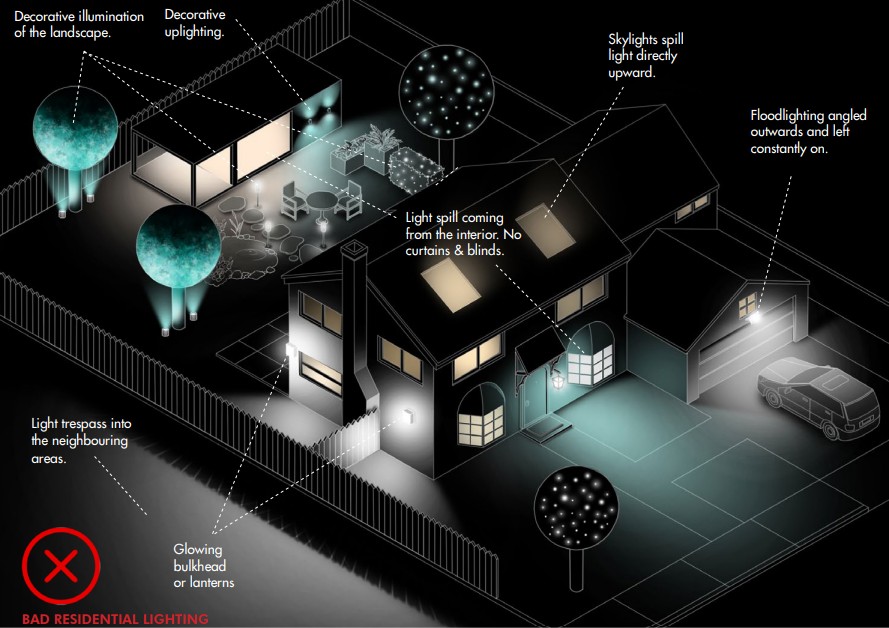

Example of good lighting practice for residential and cottage type buildings. Dark Sky Ireland’s Environmentally Friendly Lighting Guide, Kerem Asfuroglu, Dark Source
An example of useful lighting is Dark Source’s case study of a hotel located in the heart of a historic old town. The hotel is a classic example of an 18th century Ottoman home is revitalised as a boutique hotel. According to Dark Source, the aim was to recapture the historic and domestic ambiance which was once created by the light seeping into the courtyard from the interiors. As a result, exterior lighting was considered judiciously and mainly allowed through doors and windows, creating a playful contrast and a distinct night-time identity. No lighting was applied to the facades as the aim was to evoke the memory of the place; that it was, and still is, a home for its visitors. The welcoming warmth radiating from the rooms also helped with the ambition of keeping light pollution to a minimum.
Case example 2: Amenities and nearby infrastructure
 Concepts of the lighting design for the Cloughjordan Ecovillage, Kerem Asfuroglu, Dark SourceThe lighting design for Cloughjordan Ecovillage developed by Dark Source aimed to create an environmentally friendly lighting scheme sympathetic to the existing dark infrastructure and the needs of nocturnal biodiversity. An important role was also played in the development of the lighting policy, negotiations of lighting standards with the county council and related application process.
Concepts of the lighting design for the Cloughjordan Ecovillage, Kerem Asfuroglu, Dark SourceThe lighting design for Cloughjordan Ecovillage developed by Dark Source aimed to create an environmentally friendly lighting scheme sympathetic to the existing dark infrastructure and the needs of nocturnal biodiversity. An important role was also played in the development of the lighting policy, negotiations of lighting standards with the county council and related application process.Case example 3: Sport arenas, outdoor events, greenhouse and industrial lighting
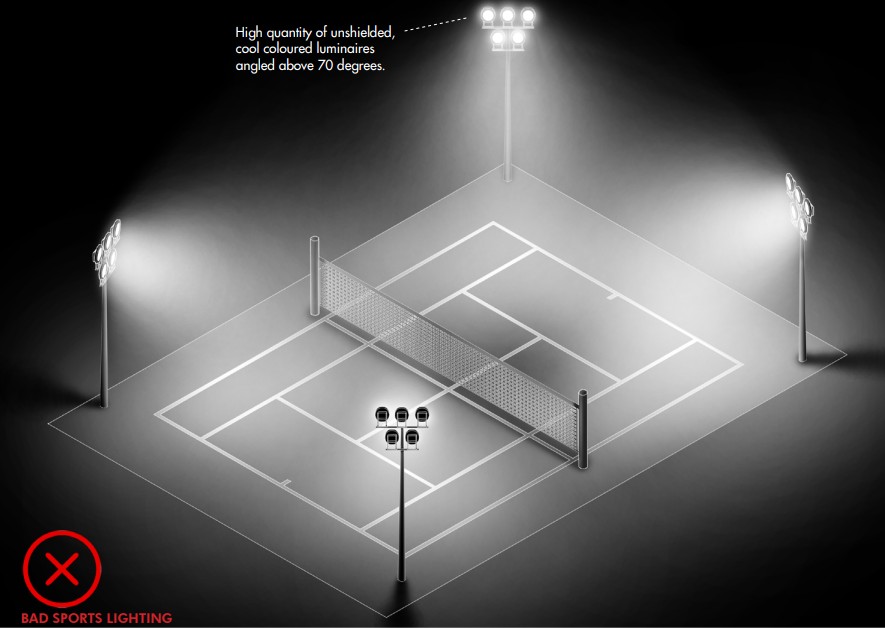
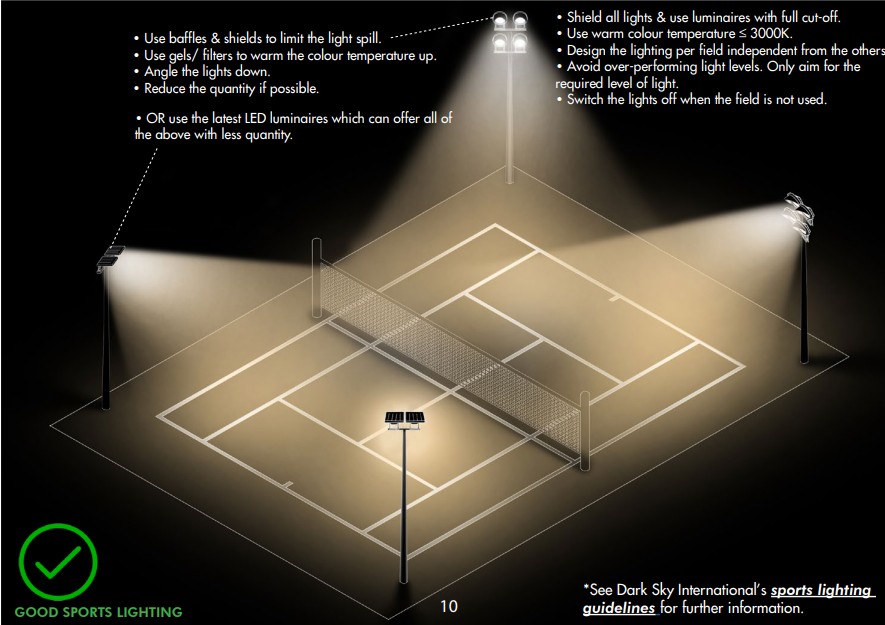 Example of good lighting practice for sport arenas. Dark Sky Ireland’s Environmentally Friendly Lighting Guide, Kerem Asfuroglu, Dark SourceMeaningful lighting takes into consideration the users, the environment and potential impacts. Sport arenas, festival lights, nighttime façade lighting, greenhouses and street and park lighting as additional amenities can impact the overall light pollution of a destination. Example of good lighting of spaces can be seen in Dark Sky Ireland’s Environmentally Friendly Lighting Guide.
Example of good lighting practice for sport arenas. Dark Sky Ireland’s Environmentally Friendly Lighting Guide, Kerem Asfuroglu, Dark SourceMeaningful lighting takes into consideration the users, the environment and potential impacts. Sport arenas, festival lights, nighttime façade lighting, greenhouses and street and park lighting as additional amenities can impact the overall light pollution of a destination. Example of good lighting of spaces can be seen in Dark Sky Ireland’s Environmentally Friendly Lighting Guide.Case example 4: Large scale and multi-storey buildings
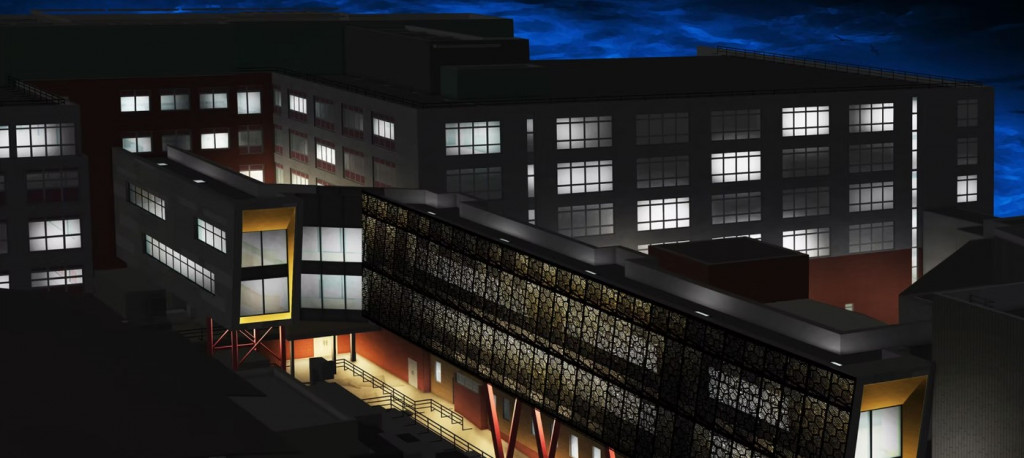 Concept visuals for NHS UHS Skyway. Kerem Asfuroglu, Dark Source
Concept visuals for NHS UHS Skyway. Kerem Asfuroglu, Dark SourceLarge infrastructures such as hospitals, industrial facilities, libraries, and schools can significantly contribute to the overall light pollution of a destination. Responsible lighting is therefore essential when designing new lighting systems or upgrading existing ones.
In collaboration with the NHS University Hospital Southampton and BAM, Dark Source designed the exterior lighting of Skyway with the aim of creating a distinct night-time character for the link bridge that enhances at the same time the experience of the site using dynamic illumination. As can be seen, warm-white downward lighting is directed in a thoughtful manner to minimise the upward spill and to keep the scheme environmentally-friendly.Case example 5: Statues & heritage sites
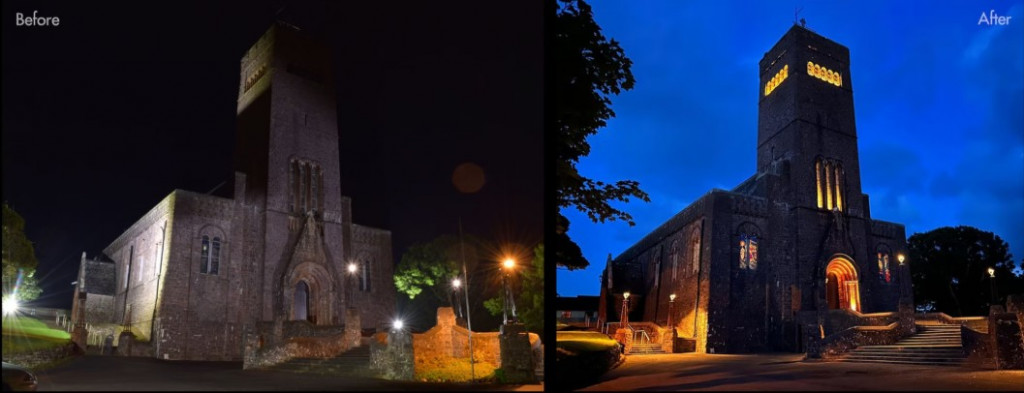 St Patrick's Church was re-lit as a part of the Newport Dark Sky Masterplan by Dark Source. Pictures: Georgia MacMillan, Dark SourceStatues and heritage sites are important attractions for tourism. How they are lit, meaningfully or excessively and unthoughtfully, can make them attractive or ignored. Located in County Mayo in Ireland, Newport Dark Sky Masterplan was developed by Dark Source in collaboration with Mayo Dark Skies. Working closely with the local community, the project aimed to eliminate light pollution through new lighting design but also balance the visual, social and environmental objectives for the town to protect dark skies and enhancing night-time experience for both people and biodiversity. St Patrick’s Church, forming the first completed phase of the project, resulted in nearly 2 tonnes of CO2e reduction per year conveying a powerful night-time image that meaningful lighting is also a climate positive action.
St Patrick's Church was re-lit as a part of the Newport Dark Sky Masterplan by Dark Source. Pictures: Georgia MacMillan, Dark SourceStatues and heritage sites are important attractions for tourism. How they are lit, meaningfully or excessively and unthoughtfully, can make them attractive or ignored. Located in County Mayo in Ireland, Newport Dark Sky Masterplan was developed by Dark Source in collaboration with Mayo Dark Skies. Working closely with the local community, the project aimed to eliminate light pollution through new lighting design but also balance the visual, social and environmental objectives for the town to protect dark skies and enhancing night-time experience for both people and biodiversity. St Patrick’s Church, forming the first completed phase of the project, resulted in nearly 2 tonnes of CO2e reduction per year conveying a powerful night-time image that meaningful lighting is also a climate positive action.Case example 6: Garden lights, streetlights, walking paths
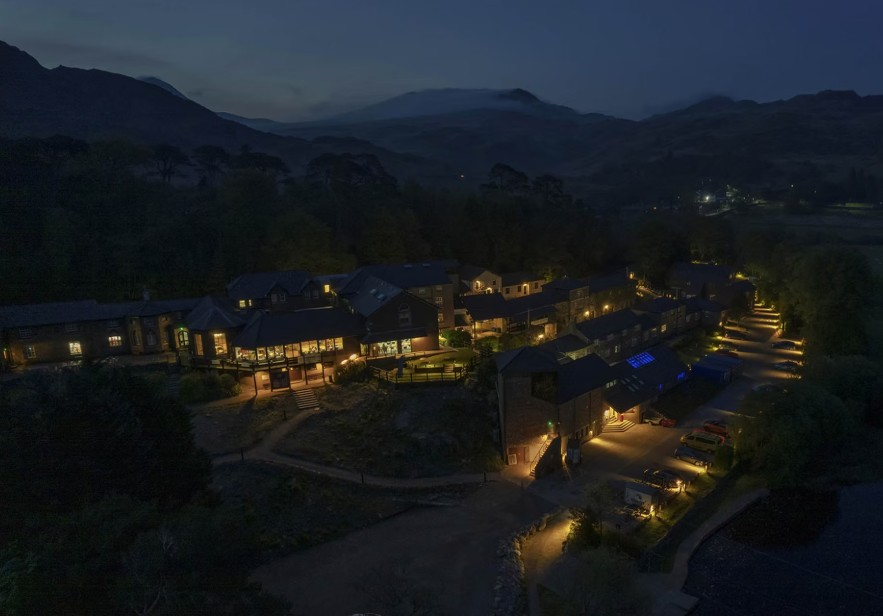 Plas y Brenin Outdoor Centre dark sky friendly exterior lighting. Picture: Dylan Evans, Dark SourceAttractions are among the most important elements that draw visitors to a destination. These include historical and cultural sites, accommodation, architecture, landscapes, farms, wildlife, and natural heritage. Activities are often built around these attractions to enhance the tourist experience—such as enjoying natural beauty, observing wildlife, or experiencing the night sky. Excessive or misdirected artificial lighting can diminish the aesthetic appeal of these attractions, harm the environment, and increase energy costs.Located in the heart of Snowdonia, Plas y Brenin Outdoor Centre was developed by Dark Source in collaboration with Snowdonia National Park Authority & Prosiect Nos. The dark sky friendly exterior lighting project aimed to reduce energy and material waste and impact biodiversity while creating inviting night-time experience. Besides restoring its dark skies and reducing annual CO2 emission by 2 tonnes, the project has won several design awards and was featured by BBC One's Countryfile.
Plas y Brenin Outdoor Centre dark sky friendly exterior lighting. Picture: Dylan Evans, Dark SourceAttractions are among the most important elements that draw visitors to a destination. These include historical and cultural sites, accommodation, architecture, landscapes, farms, wildlife, and natural heritage. Activities are often built around these attractions to enhance the tourist experience—such as enjoying natural beauty, observing wildlife, or experiencing the night sky. Excessive or misdirected artificial lighting can diminish the aesthetic appeal of these attractions, harm the environment, and increase energy costs.Located in the heart of Snowdonia, Plas y Brenin Outdoor Centre was developed by Dark Source in collaboration with Snowdonia National Park Authority & Prosiect Nos. The dark sky friendly exterior lighting project aimed to reduce energy and material waste and impact biodiversity while creating inviting night-time experience. Besides restoring its dark skies and reducing annual CO2 emission by 2 tonnes, the project has won several design awards and was featured by BBC One's Countryfile.Case example 7: Tourism support infrastructure and amenities renovations
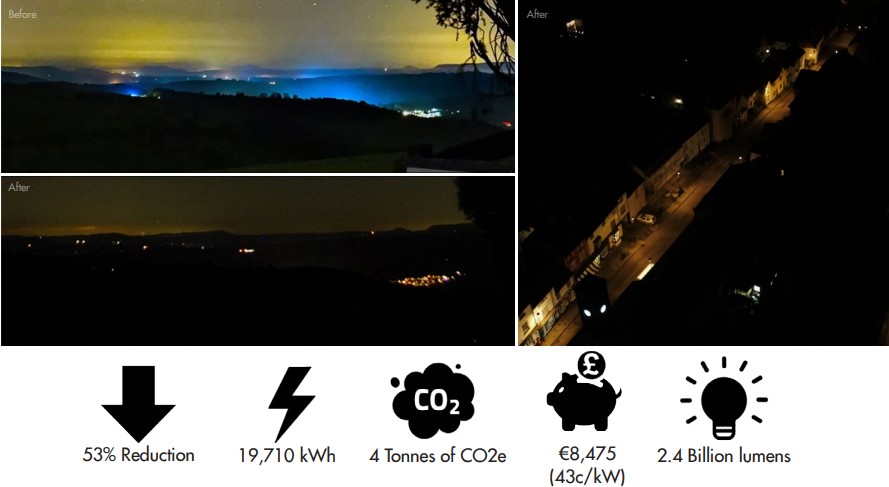 Presteigne & Norton is certified as the first International Dark Sky Community in Wales. Pictures: Leigh Harling-Bowen & Buzz Drones, Dark SourceResponsible and meaningful lighting at night can be considered as a solution during future renovations and refurbishing of certain essential lighting, to limit irresponsible and unnecessary lighting. The towns of Presteigne & Norton are located in County Powys, Wales’s largest and most rural county that borders England. There, a total of 380 lighting columns were refurbished with 2200K LED luminaires, with about half of those not useful or needed at certain times programmed to switch off, and the remaining useful and needed set to dim by 50% after midnight. This project which led to the first International Dark Sky Community in Wales has reduced its annual CO2 emissions by 4 tonnes.
Presteigne & Norton is certified as the first International Dark Sky Community in Wales. Pictures: Leigh Harling-Bowen & Buzz Drones, Dark SourceResponsible and meaningful lighting at night can be considered as a solution during future renovations and refurbishing of certain essential lighting, to limit irresponsible and unnecessary lighting. The towns of Presteigne & Norton are located in County Powys, Wales’s largest and most rural county that borders England. There, a total of 380 lighting columns were refurbished with 2200K LED luminaires, with about half of those not useful or needed at certain times programmed to switch off, and the remaining useful and needed set to dim by 50% after midnight. This project which led to the first International Dark Sky Community in Wales has reduced its annual CO2 emissions by 4 tonnes.Case example 8: Infrastructure and buildings next to biodiversity sensitive areas
 Lighting recommendations for areas close to sensitive or protected areas. Kerem Asfuroglu, Dark Source
Lighting recommendations for areas close to sensitive or protected areas. Kerem Asfuroglu, Dark SourceArtificial light at night can attract pollinators and pest-controlling organisms, distracting them away from their natural behaviours. With pollinator populations in global decline, this raises concerns for both crop and wild plant pollination. Protected areas such as national parks are vital for tourism and biodiversity. They provide essential ecosystem services like clean air, food, and climate regulation. When close to sensitive habitats like protected areas or Natura sites (link), the use of light at night needs to be considered more carefully and mitigation measures put in place, or, ideally, no light used at all, for example during nesting or migration periods.
Kamel Spoelstra and colleagues have run ALAN experiments in the Netherlands since 2010, examining the impacts of different colours of street lamp lights on wildlife, including bats, insects, mice, voles and birds (link). They noted that the least impactful colour of LED light was red light which mimicked that of the dark control areas. Dark Sky Ireland advises on the use of warm colour temperature, suitable power and intensity, appropriate beam distribution, mounting height and tilt angle employed with a dimming or switch-off schedule.